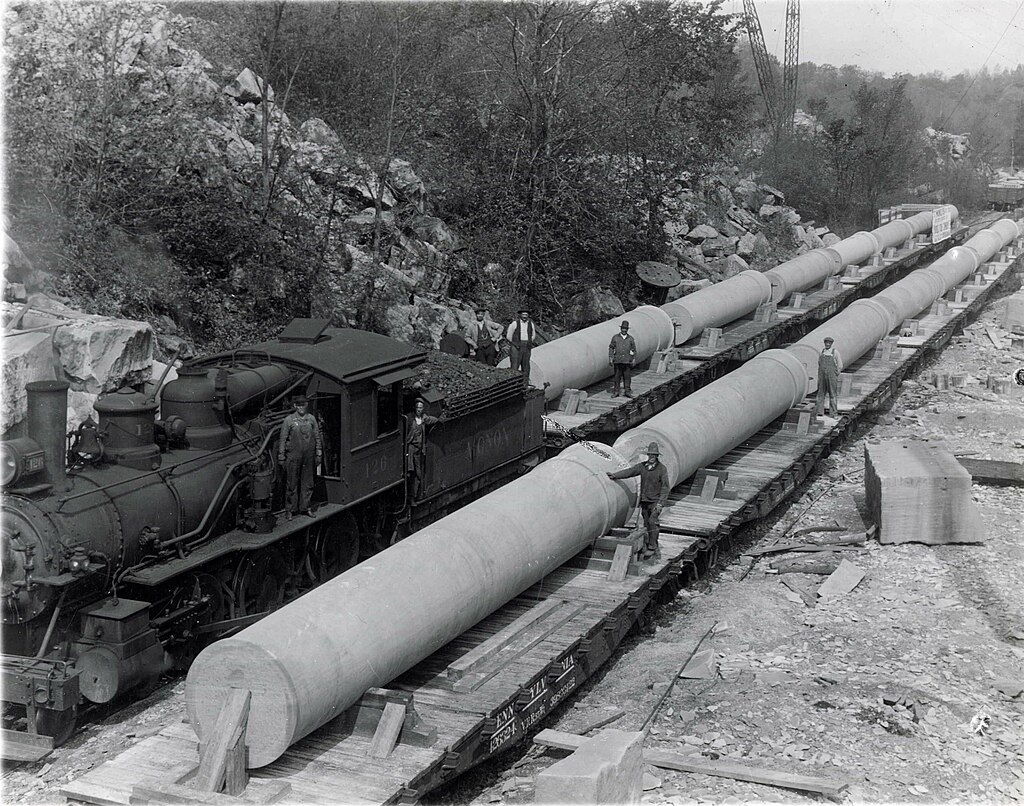
LAWRENCE COUNTY- June is Limestone Month, which is very special to Hoosiers in Lawrence County. Without Limestone Bedford would never have grown into the vibrant community it is, if it had survived at all. There are many silent tributes throughout the United States in the form of art and architecture dedicated to the beauty and unique quality of the stone and the local masons who carved it.
Lawrence County’s rich limestone quarrying and carving history began in the early 1800s. Since then, the county has been known as “Limestone Country.” Many of America’s famous buildings were built of stone quarried from Limestone Country, including the Empire State Building, Chicago’s Tribune Tower, the Pentagon, and the new Yankee Stadium. Limestone is found underground in the Stone Belt, a unique area in Lawrence County and nearby Monroe County that is only 35 miles long and 10 miles wide. It gives the area rolling hills and has been transformed into stunning buildings and statues. There are many ways to see, touch, and learn about the stone that built our community.

Native Americans were the first people to discover limestone in Indiana. Not long after they arrived, American settlers used this rock around their windows and doors and for memorials around the towns. The first quarry was started in 1827, and by 1929, Hoosier quarries yielded 12,000,000 ft3 (340,000 cubic meters) of usable stone. The expansion of the railroads brought a great need for limestone to build bridges and tunnels, and Indiana was the place to get it.
American architecture of the late 19th and early 20th century included much limestone detail work on buildings, but as architectural styles changed, so did the demand for limestone. Indiana limestone was officially designated as the state stone of Indiana by the Indiana General Assembly in 1971. With the Arab Oil Embargo of 1973, the price of alternative building materials skyrocketed, so Indiana limestone reemerged as an energy-efficient building material.
Local
Many of Indiana’s official buildings, such as the State capitol building, the monuments in Downtown Indianapolis, the Indiana University Robert H. McKinney School of Law, many university buildings, and the Indiana Government Center, and most of the state’s 92 courthouses are all examples of Indiana architecture made with Indiana limestone. The majority of Indiana University, Bloomington, was constructed out of limestone. 1959’s architecturally significant St. Augustine’s Episcopal Church in Gary, Indiana, uses Indiana limestone in the interior. The Saint Sava Serbian Orthodox Church in Merrillville, Indiana, consecrated in 1991 and awarded a Gold Medal Award for Excellence in Masonry Design, uses Indiana limestone on its exterior facade.
National
Indiana limestone has long been part of a high-end market nationally. It is mostly used in the exteriors of homes, commercial buildings, and government buildings.
Many prominent public buildings in the United States — such as the National Cathedral, Biltmore Estate, Empire State Building, the Pentagon, The Crescent in Dallas, and the Hotel Pennsylvania — feature Indiana limestone in their exteriors. Some 35 of the 50 state capitol buildings in the United States are made of Indiana limestone. It was used extensively in rebuilding Chicago after the Great Chicago Fire of 1871. The sculptural group atop the main façade of New York City’s Grand Central Terminal — known as Glory of Commerce — is made of Indiana Limestone. (A work by Jules-Félix Coutan includes representations of Minerva, Hercules, and Mercury and, at its unveiling in 1914, was considered the largest sculptural group in the world.
The original 1930s buildings of Rockefeller Center use limestone from Bedford. In 1955, the Tennessee State Capitol exterior was renovated using Indiana limestone to replace the poorer-quality Tennessee limestone that had started deteriorating. Some 15,000 cubic feet of Indiana limestone was used in the rebuilding of the Pentagon after the terrorist attack of Sept. 11, 2001. The new Yankee Stadium in the Bronx, which opened in 2009, extensively uses Indiana limestone paneling on its exterior facade.
Indiana limestone has been particularly popular for the construction of university buildings. The Neo-Gothic campus of the University of Chicago is almost entirely constructed of Indiana limestone, which is in keeping with the trend of post-fire buildings using this material. The campus of Washington University in St. Louis – both for new construction and original buildings – uses Indiana limestone in its collegiate gothic architecture. Many buildings on the north side of Michigan State University use Indiana limestone. The Cathedral of Learning, a 42-story neo-gothic skyscraper that is the largest educational building in the Western Hemisphere, and other nearby buildings of the University of Pittsburgh are clad in Indiana limestone. The St. Anthony Society Chapter House at Yale University also is built of Indiana limestone. Many of the gargoyles on the buildings of Princeton University were carved from Indiana limestone, including “Flute Player”, located on the exterior of Firestone Library. Both structures of the Kenosha County Courthouse and Jail in Kenosha, Wisconsin, were built out of limestone. This stone was used as far north as the Hotel Macdonald in Edmonton. The Nebraska State Capitol is clad in Indiana Limestone after native limestone was deemed too prone to weathering.[10]
Because of the awareness of acid rain, which wears Indiana Limestone relatively quickly, the stone is not as often used in monuments today as it was in the 19th and early 20th centuries.



